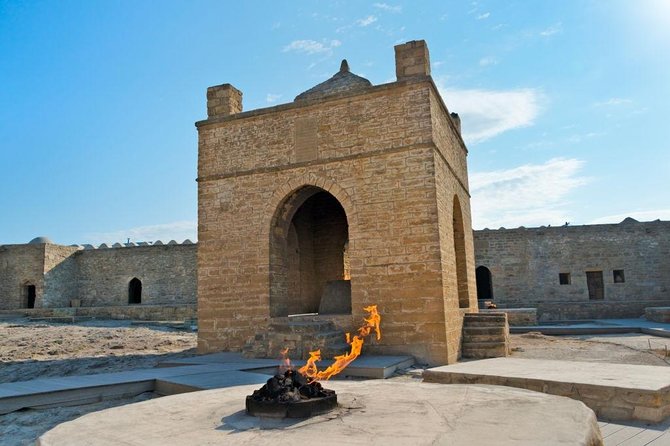The Azerbaijan Fire Temple, also known as Ateshgah, is a historical religious site located in Surakhani, near Baku, Azerbaijan. This temple, dating back to the 17th and 18th centuries, was built by Zoroastrian, Hindu, and Sikh communities. Its unique architecture features a central altar surrounded by a pentagonal structure with cells for monks and pilgrims. The Azerbaijan Fire Temple name, derived from the Persian word for "home of fire," reflects its significance as a place of worship where natural gas seeps fueled eternal flames, symbolizing the divine presence.
Ancient History of Azerbaijan
The history of Azerbaijan has a rich and independent history. The territory of Azerbaijan is considered as one of the lands inhabited by the first people. Because the lands of Azerbaijan are fertile, enemies have always tried to capture them. The first settlements were formed in Azerbaijan since ancient times. Located at the intersection of Eastern Europe and Western Asia, Azerbaijan has an ancient history. This nation's roots go back to antiquity, revealing a mosaic of cultures, civilizations and influences that have shaped its identity for millennia. From Bronze Age settlements along the Caspian Sea to Silk Road exchanges that brought together different societies, Azerbaijan's ancient history is a testament to its enduring role as a cultural bridge connecting East and West.
The Meaning of the Name Azerbaijan
There are different opinions about the origin of the name Azerbaijan. According to the legend, after the death of Alexander, he established an independent state in the territories he ruled, and this state was named Atropatena after Atropate. The name Azerbaijan was born from the name Atropatena. In another tradition, the name "Azerbaijan" means "hilly, hilly foothills, mountain range".The word "Azer" mainly means fire, light and light. "Baycan" means strong and stable. Therefore, the name "Azerbaijan" can be translated as "without fire, without light" or "resistant to fire".
Historical architectural monuments of Azerbaijan
There are many historical architectural monuments in Azerbaijan. The reason for this is that the compatibility of the ecological structure of Azerbaijan also depends on the mild natural conditions of Azerbaijan. Various caves have existed in Azerbaijan since ancient times. There are various caves in Kalbajar, Nakhchivan, Goyche, Shamakhi, Fuzuli. Each building has left an indelible mark on the architectural heritage of Azerbaijan. There are Sheki Khan Palace, Maiden Castle, Ateshgah, Shamakhi Castle, Mardakan Castle and architectural monuments in Azerbaijan. The infrastructure of each resonates with modern times.
Ancient Ateshgah Fire Temple
The Ateshgah Fire Temple is an ancient religious building located in the Surakhani settlement of Baku, the capital of Azerbaijan. The temple was originally built in the 17th and 18th centuries, although the site has an even older history. The temple complex is known for its distinctive pentagonal shape with an open courtyard in the center. The main structure houses cells and a round altar in the middle. With the discovery of oil and the emergence of modern energy sources, the natural gas fueling the temple's flame gradually diminished. The temple lost its religious significance and was eventually closed in the late 19th century. In the 20th century, the Soviet government recognized the historical and architectural value of the Ateshgah Fire Temple and preserved it as a museum.
Ateshgah
Ateshgah stands as a testament to the rich cultural heritage and historical significance of Azerbaijan. Its intricate architecture, steeped in Zoroastrian and Islamic influences, captivates visitors, offering a glimpse into centuries of spiritual devotion and architectural brilliance. Beyond its religious significance, Ateshgah serves as a symbol of the enduring cultural legacy of the region, inviting travelers to immerse themselves in its mystique and unravel the tales of bygone eras. As visitors depart this sacred site, they carry with them not just memories, but a deeper appreciation for the diverse tapestry of history that has shaped Azerbaijan into the vibrant nation it is today.
The Historical Significance of the Azerbaijan Fire Temple
The historical significance of the Azerbaijan Fire Temple lies in its testament to the region's ancient Zoroastrian roots. Located in Surakhani, near Baku, it served as a place of worship for fire-worshippers, symbolizing the sacred element of fire in Zoroastrianism. The temple's unique pentagonal structure and central altar, where natural gas seepage once fueled eternal flames, highlight the confluence of natural phenomena and religious practices. Over centuries, it also attracted Hindu and Sikh pilgrims, reflecting its multicultural spiritual importance. The historical significance of the Azerbaijan Fire Temple stands as a cultural and architectural landmark, preserving the rich religious heritage of Azerbaijan.
The Architecture of the Ateshgah
The architecture of the Ateshgah is unique and different. Constructed in the 17th and 18th centuries, its design is a fascinating blend of Persian, Indian, and Azerbaijani architectural styles, reflecting the cultural melting pot of the region. The architecture of the Ateshgah is a pentagonal complex with a central altar where natural gas vents create eternal flames, which are central to Zoroastrian worship. Surrounding the altar are a series of cells for monks and pilgrims, built with sandstone and adorned with inscriptions in Sanskrit and Punjabi. The architecture of the Ateshgah embodies the syncretic religious and cultural practices of its time, making it a significant historical and cultural landmark.
Reasons Why Tourists Come to Ancient Ateshgah Fire Temple
Today, the Ateshgah Temple operates as a museum, showcasing exhibits related to Zoroastrianism and the historical context of the temple. It has become a popular tourist attraction, drawing visitors interested in history, culture, and architecture. The site's mesmerizing architecture, featuring intricate carvings and distinctive fire altars, captivates visitors, offering a glimpse into the ancient spiritual practices of the region. Additionally, the temple's connection to the natural phenomenon of burning natural gas vents adds to its allure, creating an unforgettable experience for those seeking to explore the fascinating blend of religious history and architectural beauty that the Ancient Ateshgah Fire Temple offers.
Conclusion - Azerbaijan Fire Temple
In conclusion, Azerbaijan Fire Temple, also known as Ateshgah, stands as a remarkable testament to the religious and cultural heritage of Azerbaijan. This historic site, once a place of worship for Zoroastrians, Hindus, and Sikhs, embodies the rich tapestry of spiritual and cultural influences that have shaped the region over centuries. Its unique architecture and enduring significance offer a window into the diverse traditions that have coexisted in Azerbaijan. Today, the Azerbaijan Fire Temple not only preserves the ancient rituals of fire worship but also serves as a symbol of the country's historical openness and multicultural legacy, attracting visitors and scholars from around the world.


 Golf Club
Golf Club
 DMC in Azerbaijan
DMC in Azerbaijan
.png) Hunting in Azerbaijan - Hunting Tours in Azerbaijan
Hunting in Azerbaijan - Hunting Tours in Azerbaijan
.png) Azerbaijan Hotel Booking – Baku hotel Booking
Azerbaijan Hotel Booking – Baku hotel Booking
.png) Tour Guide in Azerbaijan
Tour Guide in Azerbaijan
 Transfer
Transfer